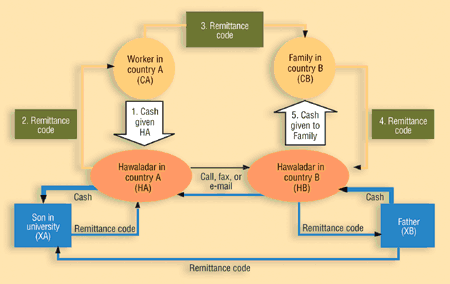 About F&D Subscribe Back Issues Write Us Copyright Information Free Email Notification Receive emails when we post new
items of interest to you. |
Hawala Mohammed El-Qorchi How does this informal funds transfer system work, and should it be regulated? Since the September 11, 2001, terrorist attacks on the United States, public interest in informal systems of transferring money around the world, particularly the hawala system, has increased. The reason is the hawala system's alleged role in financing illegal and terrorist activities, along with its traditional role of transferring money between individuals and families, often in different countries. Against this background, governments and international bodies have tried to develop a better understanding of these systems, assess their economic and regulatory implications, and design the most appropriate approach for dealing with them. Informal funds transfer (IFT) systems are in use in many regions for transferring funds, both domestically and internationally. The hawala system is one of the IFT systems that exist under different names in various regions of the world. It is important, however, to distinguish the hawala system from the term hawala, which means "transfer" or "wire" in Arabic banking jargon. The hawala system refers to an informal channel for transferring funds from one location to another through service providers—known as hawaladars—regardless of the nature of the transaction and the countries involved. While hawala transactions are mostly initiated by emigrant workers living in a developed country, the hawala system can also be used to send funds from a developing country, even though the purpose of the funds transfer is usually different (see box).

Why hawala developed In earlier times, IFT systems were used for trade financing. They were created because of the dangers of traveling with gold and other forms of payment on routes beset with bandits. Local systems were widely used in China and other parts of East Asia and continue to be in use there. They go under various names—Fei-Ch'ien (China), Padala (Philippines), Hundi (India), Hui Kuan (Hong Kong), and Phei Kwan (Thailand). The hawala (or hundi) system now enjoys widespread use but is historically associated with South Asia and the Middle East. At present, its primary users are members of expatriate communities who migrated to Europe, the Persian Gulf region, and North America and send remittances to their relatives on the Indian subcontinent, East Asia, Africa, Eastern Europe, and elsewhere. These emigrant workers have reinvigorated the system's role and importance. While hawala is used for the legitimate transfer of funds, its anonymity and minimal documentation have also made it vulnerable to abuse by individuals and groups transferring funds to finance illegal activities. Economic and cultural factors explain the attractiveness of the hawala system. It is less expensive, swifter, more reliable, more convenient, and less bureaucratic than the formal financial sector. Hawaldars charge fees or sometimes use the exchange rate spread to generate income. The fees charged by hawaladars on the transfer of funds are lower than those charged by banks and other remitting companies, thanks mainly to minimal overhead expenses and the absence of regulatory costs to the hawaladars, who often operate other small businesses. To encourage foreign exchange transfers through their system, hawaladars sometimes exempt expatriates from paying fees. In contrast, they reportedly charge higher fees to those who use the system to avoid exchange, capital, or administrative controls. These higher fees often cover all the expenses of the hawaladars. The system is swifter than formal financial transfer systems partly because of the lack of bureaucracy and the simplicity of its operating mechanism; instructions are given to correspondents by phone, facsimile, or e-mail; and funds are often delivered door to door within 24 hours by a correspondent who has quick access to villages even in remote areas. The minimal documentation and accounting requirements, the simple management, and the lack of bureaucratic procedures help reduce the time needed for transfer operations. In addition to economic factors, kinship, ethnic ties, and personal relations between hawaladars and expatriate workers make this system convenient and easy to use. The flexible hours and proximity of hawaladars are appreciated by expatriate communities. To accommodate their clients, hawaladars may instruct their counterparts to deliver funds to beneficiaries before expatriate workers make payments. Moreover, cultural considerations encourage expatriate workers to remit funds through the hawala system, and such considerations also apply to family members in the home country. Many expatriate communities are exclusively male, because wives and other family members remain in the home country, where family traditions prevail. These traditions may require family members, especially women, to maintain minimal contacts with the outside world. A trusted hawaladar, known in the village and aware of the social codes, would be an acceptable intermediary, protecting women from having direct dealings with banks and other agents. Thus, a system based on national, ethnic, and village solidarity depends more on absolute trust between the participants than on legal documents. On the receiving side, repressive financial policies and inefficient banking institutions, which have often lacked interest in the remittance business, have contributed to the development of IFT systems. In addition to overly restrictive economic policies, unstable political situations have offered fertile ground for the development of the hawala and other informal systems. Most IFT systems have prospered in areas characterized by unsophisticated official systems and during times of instability. They continue to develop in regions where financial development has been slow or repressed. Overall, financial development tends to check the spread of informal fund transfer systems, even though they exist in financially mature countries as well. Economic implicationsDespite its informality, the hawala system has direct and indirect macroeconomic implications—for financial activity as well as for fiscal performance. One aspect is its potential impact on the monetary accounts of countries on either end of the hawala transaction. Because these transactions are not reflected in official statistics, the remittance of funds from one country to another is not recorded as an increase in the recipient country's foreign assets or in the remitting country's liabilities, unlike funds transferred through the formal sector. As a consequence, value changes hands, but broad money is unaltered. However, hawala transactions may affect the composition of broad money in a recipient country. In the remittance business, such transactions are conducted mainly in cash, even though hawaladars may use the banking system for other purposes. Individuals from developing countries who transfer funds abroad through the hawala system for investment or other purposes are usually members of wealthy groups. They supply local hawaladars with cash by making withdrawals from their bank accounts. As a consequence, hawala-type transactions tend to increase the amount of cash in circulation. Furthermore, IFT systems have fiscal implications for both remitting and receiving countries because no direct or indirect tax is paid on hawala transactions. The negative impact on government revenue applies equally to both legitimate and illegitimate activities that involve the hawala system. Hawala transactions cannot be reliably quantified because records are virtually inaccessible, especially for statistical or balance of payments purposes. This holds true for both the remitting and, especially, the receiving sides of the transactions. Hawala transactions from developing countries are sometimes driven by capital flight motivations; they may also be driven by a desire to circumvent exchange control regulations and the like, leaving no traceable records. Nevertheless, the authorities of some countries have sporadically made estimates of hawala activity based on their expatriate populations and balance of payments data. In any case, all crude estimates should take into account both hawala and reverse hawala transactions (see box) as well as transactions driven by illicit activities. Although it would be impossible to provide a precise figure, the amounts involved in hawala transactions are likely to entail billions of dollars. Difficulties for regulatorsThere is also a consensus that, in the wake of heightened international efforts to combat money laundering and terrorist financing, more should be done to keep an eye on IFT systems to avoid their misuse by illicit groups. Policymakers believe that the potential anonymity afforded by these systems presents risks of money laundering and terrorist financing that need to be addressed. Yet selecting the appropriate regulatory and supervisory response requires a realistic and practical assessment and an understanding of the specific country environment in which the IFT dealers operate. Regulation of IFT systems in various jurisdictions will be a complex endeavor. The variety of legal systems and economic circumstances across countries make a uniform approach technically and legally impractical. In a number of countries, the hawala system is prohibited. Any attempt to regulate this system in these countries would, therefore, be at odds with existing laws and regulations and would be seen as legitimizing parallel foreign exchange operations and capital flight. Where IFT regulations are conceivable, there is agreement that overregulation and coercive measures will not be effective because they might push IFT businesses, including legitimate ones, further underground. The purpose of any approach is not to eliminate these systems but to avoid their misuse. Against this background, policymakers tend to favor two options, which are already in force in some countries: registration or licensing of IFT systems. While these measures could deter illegal activities, they will not, in isolation, succeed in reducing the attractiveness of the hawala system. As a matter of fact, as long as there are reasons for people to prefer such systems, they will continue to exist and even expand. If the formal banking sector intends to compete with the informal remittance business, it should focus on improving the quality of its service and reducing the fees charged. Therefore, a longer-term and sustained effort should be aimed at modernizing and liberalizing the formal financial sector, with a view to addressing its inefficiencies and weaknesses.
|